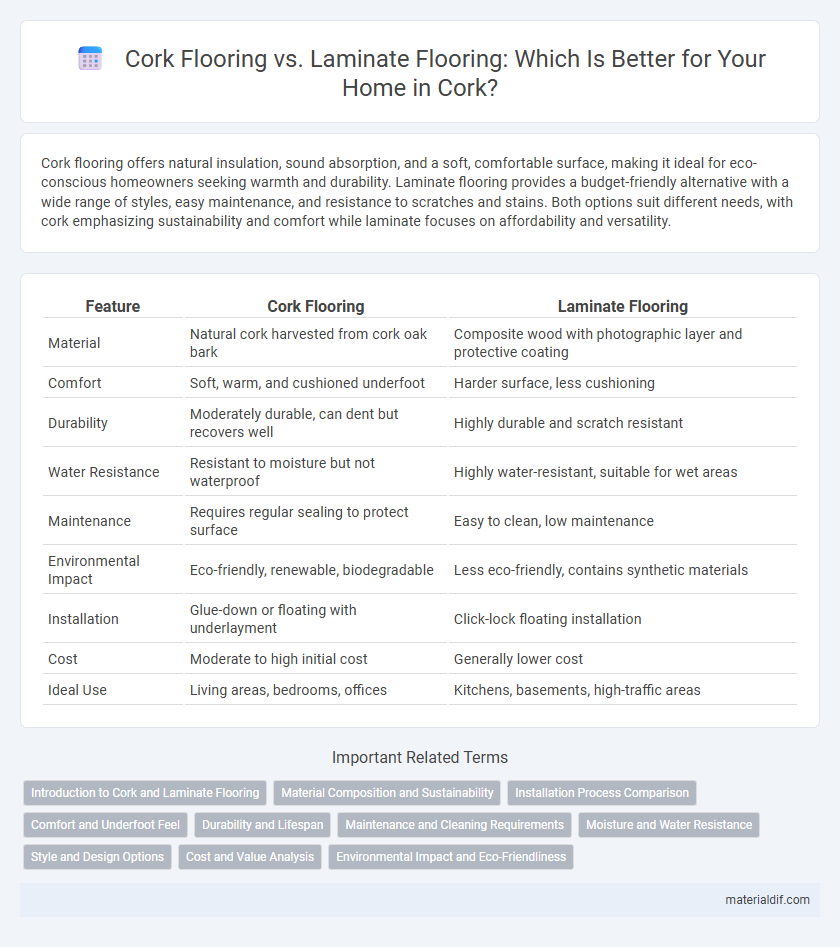Cork flooring offers natural insulation, sound absorption, and a soft, comfortable surface, making it ideal for eco-conscious homeowners seeking warmth and durability. Laminate flooring provides a budget-friendly alternative with a wide range of styles, easy maintenance, and resistance to scratches and stains. Both options suit different needs, with cork emphasizing sustainability and comfort while laminate focuses on affordability and versatility.
Table of Comparison
| Feature | Cork Flooring | Laminate Flooring |
|---|---|---|
| Material | Natural cork harvested from cork oak bark | Composite wood with photographic layer and protective coating |
| Comfort | Soft, warm, and cushioned underfoot | Harder surface, less cushioning |
| Durability | Moderately durable, can dent but recovers well | Highly durable and scratch resistant |
| Water Resistance | Resistant to moisture but not waterproof | Highly water-resistant, suitable for wet areas |
| Maintenance | Requires regular sealing to protect surface | Easy to clean, low maintenance |
| Environmental Impact | Eco-friendly, renewable, biodegradable | Less eco-friendly, contains synthetic materials |
| Installation | Glue-down or floating with underlayment | Click-lock floating installation |
| Cost | Moderate to high initial cost | Generally lower cost |
| Ideal Use | Living areas, bedrooms, offices | Kitchens, basements, high-traffic areas |
Introduction to Cork and Laminate Flooring
Cork flooring is made from the bark of the cork oak tree, offering natural insulation, durability, and a soft underfoot feel, making it an eco-friendly choice for sustainable homes. Laminate flooring consists of a high-density fiberboard core topped with a photographic image layer and a protective wear layer, providing a cost-effective and versatile option that mimics hardwood, stone, or tile appearances. Both flooring types offer moisture resistance and ease of maintenance, but cork excels in comfort and sound absorption, while laminate is favored for its hardness and wide design variety.
Material Composition and Sustainability
Cork flooring is made from the bark of cork oak trees, harvested sustainably without harming the tree, making it a renewable and biodegradable material. Laminate flooring consists of a fiberboard core with a photographic layer and melamine resin coating, often incorporating synthetic materials with less eco-friendly production processes. Cork's natural cellular structure provides superior insulation and resilience while supporting environmentally responsible forestry practices compared to the less sustainable manufacturing of laminate options.
Installation Process Comparison
Cork flooring installation involves fitting interlocking planks or tiles over a smooth, level subfloor, often requiring an adhesive for sheet cork, which demands careful moisture barrier application to prevent damage. Laminate flooring uses a click-lock system that snaps planks together, enabling quicker, float-style installation over underlayment without adhesives, making it more DIY-friendly. Both flooring types require acclimation to Cork's humid climate, but cork installation may need more precise preparation to maintain durability and comfort.
Comfort and Underfoot Feel
Cork flooring offers exceptional comfort and a warm, cushioned underfoot feel due to its natural cellular structure that absorbs impact and reduces noise. In contrast, laminate flooring provides a harder surface with less give, often feeling colder and less forgiving underfoot. Cork's elasticity and thermal insulation make it ideal for spaces where comfort and softness underfoot are prioritized.
Durability and Lifespan
Cork flooring offers superior durability due to its natural resilience and ability to absorb impact, making it ideal for high-traffic areas in Cork homes. Laminate flooring, while cost-effective and resistant to scratches and stains, typically has a shorter lifespan, averaging 10 to 20 years compared to cork's potential 30 to 40 years with proper maintenance. Moisture resistance is higher in cork, enhancing longevity in humid Cork environments, whereas laminate may suffer warping over time if exposed to water.
Maintenance and Cleaning Requirements
Cork flooring requires regular sweeping and damp mopping with a pH-neutral cleaner to maintain its natural resilience and prevent moisture damage. Laminate flooring is easier to clean, needing only dry or slightly damp mopping, but is more susceptible to water damage if not promptly wiped. Both flooring types benefit from protective pads on furniture to avoid scratches, but cork demands more careful moisture management due to its porous nature.
Moisture and Water Resistance
Cork flooring offers superior moisture resistance due to its natural cellular structure that repels water and prevents mold growth, making it ideal for areas prone to humidity like kitchens and bathrooms. Laminate flooring, while durable and cost-effective, tends to absorb moisture through its seams, leading to swelling and warping over time without proper waterproof treatments. Choosing cork flooring enhances longevity and maintains structural integrity in wet environments, outperforming laminate in moisture and water resistance.
Style and Design Options
Cork flooring offers a unique, natural texture and warmth with eco-friendly appeal, available in various shades and patterns that enhance contemporary and rustic interiors. Laminate flooring provides a wider range of style options, replicating the look of hardwood, stone, or tile with high durability and easy maintenance. Both flooring types support diverse design preferences, but laminate excels in mimicking premium materials at a lower cost.
Cost and Value Analysis
Cork flooring offers natural insulation and durability but typically comes at a higher upfront cost compared to laminate flooring, which is more budget-friendly and easier to install. Over time, cork's resilience and eco-friendly properties provide greater long-term value, especially in moisture-prone areas, while laminate may require more frequent replacement and maintenance. Assessing total lifecycle costs reveals cork as a premium investment versus laminate's cost-effective appeal for short-term use.
Environmental Impact and Eco-Friendliness
Cork flooring offers a highly sustainable option by harvesting the cork bark without harming the tree, promoting renewable resource use and carbon sequestration. In contrast, laminate flooring typically involves synthetic materials and adhesives derived from non-renewable resources, contributing to higher carbon footprints and waste. Cork's biodegradable properties and natural resistance to mold enhance its eco-friendliness, making it a superior choice for environmentally conscious consumers in Cork.
Cork Flooring vs Laminate Flooring Infographic

 materialdif.com
materialdif.com